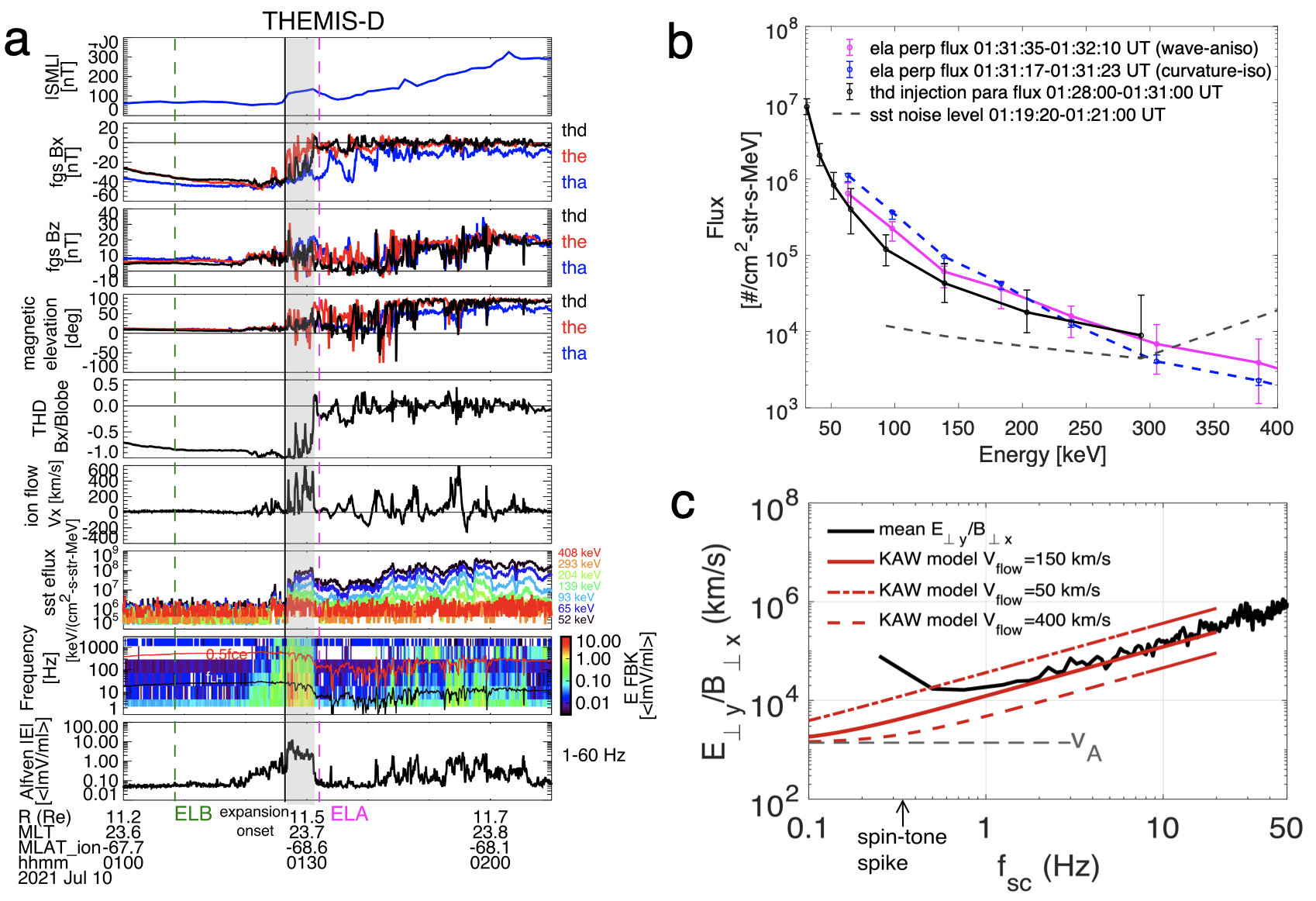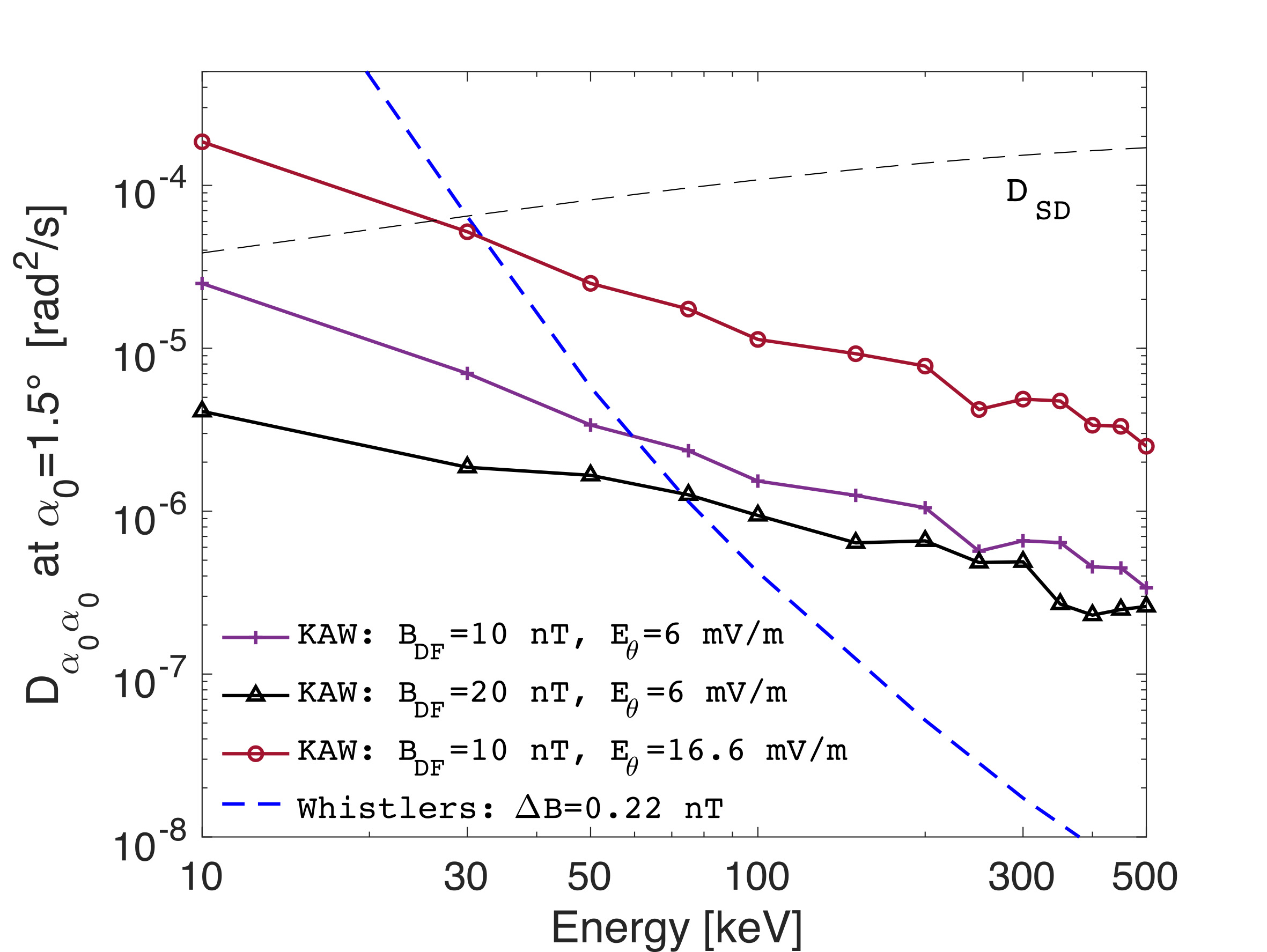
2023 THEMIS SCIENCE NUGGETS
Contribution of Kinetic Alfvén Waves to Energetic Electron Precipitation from the Plasma Sheet during a Substorm
Yangyang Shen
Earth, Planetary, and Space Sciences, UCLA
Introduction
One of the key elements of magnetosphere-ionosphere coupling is energetic (>~50 keV) electron precipitation from the magnetosphere to the ionosphere. This energetic precipitation becomes particularly significant and geoeffective during substorms, when it can cause radio transmission interference by increasing ionospheric radio absorption. Understanding the mechanisms of such precipitation is thus critical to space weather nowcasting and forecasting. Prior works have suggested that wave-particle interactions are necessary to explain the observed energetic precipitation during substorms. However, the specific wave modes and scattering mechanisms implicated in the driving of the energetic precipitation from the plasma sheet are not well understood. Our previous results have suggested that the kinetic Alfvén wave (KAW) may contribute to energetic electron precipitation from a plasma sheet injection. However, the relative role of KAWs and other scattering mechanisms in driving the precipitation has not been addressed yet. Here we address this issue using observations from the ELFIN, DMSP, and THEMIS missions, which provide approximately conjugate measurements from the vantage points of both the ionosphere and the equatorial magnetosphere during a substorm event.
Results
| Figure 1. ELFIN-THEMIS-DMSP conjunction event on 10 July 2021. (a-b) DMSP FUV auroral images measured during the substorm growth phase and expansion phase, overlaid with ionospheric (at 110 km altitude) footprints of ELFIN, THEMIS, and DMSP using T01 mapping in AACGM coordinates. The time stamps are indicated along the spacecraft trajectories with the cross symbols. (c-d) ELFIN-B (ELB) and ELFIN-A (ELA) substorm growth-phase and expansion-phase observations of near-perpendicular electron energy fluxes, along with the loss cone filling ratios (flux ratios) Jprec/Jperp spectrogram and line plots for 63, 138, and 183 keV. The isotropy boundary (or the inner edge of the plama sheet) is indicated in between the gray dashed lines, and two wave-driven precipitation regions are indicated by the rectangular boxes. |
Figure 1a and 1b show DMSP FUV auroral images in the LBHL band (160–180 nm), which were taken first by F18 and next by F17 as they traversed the aurora in the southern ionosphere during the substorm growth phase (01:00–01:15 UT) and expansion phase (01:55–02:15 UT), respectively. Figure 1b and 1c show that while ELFIN-B only observed weak and isotropic precipitation poleward of the isotropy boundary (IB, as characterized by a latitudinal boundary of isotropic fluxes at energies that dispersively decrease with increasing latitude) during the growth phase, ELFIN-A observed intense, anisotropic electron precipitation from the plasma sheet region (PS) during the substorm expansion phase. The typical plasma sheet precipitation region is identified from ELFIN based on: (a) significant near- perpendicular (bounce-trapped) fluxes are observed poleward of the IB; (b) significant down-going (precipitating) fluxes are observed at L IGRF > 7 with energies below ∼300 keV; and (c) the precipitation region is within the main auroral oval as observed by DMSP. During the growth phase (Figure 1c), the weak isotropic electron precipitation at ELFIN-B poleward of the IB is caused by field-line curvature (FLC) scattering of plasma sheet electrons due to the current sheet thinning process. During the expansion phase, the anisotropic precipitation observed near 01:32 UT from the PS shows higher loss cone filling ratios for lower-energy electrons, suggesting that scattering and loss is more efficient for lower-energy electrons than for higher-energy electrons. This energy dependence of the precipitating-to-perpendicular anisotropy ratio cannot be explained by FLC- scattering, but is very likely caused by wave scattering, which can produce more efficient electron scattering at lower energies. A similar, wave-driven precipitation region can be identified at 01:33:30 UT, except that it is located within the outer radiation belt (RB).
| Figure 2. THEMIS observations of particles and waves. Panels from top to bottom: the absolute SML index; THEMIS A, D, and E magnetic field Bx in GSM; magnetic field Bz; magnetic field elevation; THEMIS-D Bx/Blobe; THEMIS-D ion flow velocities Vx in GSM; THEMIS-D SST electron energy flux within 50–500 keV; THEMIS-D filter- bank (FBK) electric field spectra; integrated FBK wave electric field within 1–60 Hz. Note that the magnetic latitudes (MLAT) are calculated at the ionospheric footprints (∼110 km) in (Altitude-adjusted corrected geomagnetic) AACGM coordinates. (b) Comparison of differential number flux energy-spectra measured by THEMIS-D during injection periods (solid black line, 01:28:00–01:31:00 UT, see Panel a), by ELFIN-A within the ionospheric wave-driven, anisotropic precipitation region (solid magneta line, 01:31:35–01:32:10 UT, see wave- driven-1 in Figure 1d), and by EFLIN-A near the poleward boundary of the auroral precipitation region (dashed blue line, 01:31:17–01:32:23 UT, see Figure 1d). Median values of the spectra are shown along with errorbars. The gray-dashed line indicates the noise-level spectrum during the growth phase, when no significant energetic injection fluxes were observed. (c) Mean E ⊥y /B ⊥x spectra in the field-aligned coordinates in comparison with the model prediction of KAW dispersion relation. The plasma parameters used for the KAW model are based on THEMIS observations at this time. The local Alfvén speed vA ∼1,400 km/s is shown as the gray dashed line. Note that the spurious spectral amplitude increase near 0.33 Hz is due to spin-periodic spikes in the DC-coupled electric field measurements. |
Figure 2 presents that after the substorm onset near 01:26:40 UT, as evidenced by the sudden increase in the SML index, a sharp increase of particle fluxes (seventh panel from top), along with multiple dipolarizing flux bundles (DFBs), intense Alfvénic broadband waves and ion bursty bulk flows (BBFs), engulfed the spacecraft and was sustained almost an hour. The injected electrons had maximum energies of >500 keV and the broadband low-frequency (1–60 Hz) waves had a mean absolute electric field amplitude of >10 mV/m. The broadband waves in the beginning of the injection near 01:27–01:31 UT consist mainly of KAWs and time domain structures (TDSs), whereas only ~10-min later after 01:40 UT there exist additionally whistler-mode waves. To confirm that the injection near the equator observed by THEMIS is related to the wave-driven precipitation event observed at ELFIN-A, we compare in Figure 2b the energy-spectrum of the parallel- to-B differential number flux (pitch angles less than 22.5° from the field line) at THEMIS-D (black solid line) with the perpendicular number flux energy-spectrum measured at ELFIN-A (magenta solid line). Nearly identical spectra are observed at THEMIS-D during the injection period (01:28–01:31 UT) and at ELFIN-A within the wave-driven, anisotropic precipitation period (01:31:35–01:32:10 UT). We thus conclude that the plasma sheet injection fluxes measured by THEMIS-D during 01:28–01:31 UT are likely associated with the wave-driven, anisotropic precipitation at ELFIN-A around 01:32 UT. Figure 2c demonstrates that the measured large-amplitude mean wave fields (the black curve) are consistent with those predicted by the KAW model (the red lines), for an average ion flow velocity of 150 km/s, similar to that measured by THEMIS-D.
| Figure 3. Electron bounce-averaged diffusion coefficients as a function of energy for an equatorial pitch angle α 0 = 1.5° due to resonant scattering by the observed KAWs (solid lines) and whistler-mode (blue dashed line) waves from THEMIS. The diffusion rates for KAWs are obtained from test particle simulations with a KAW broadband spectrum E θ = 6 mV/m, ν = 0.5, where the KAW wave normal angle θ is assumed uniform within [83°, 87°]. To account for full ranges of KAW power in observations, we also show results with KAW E θ = 16.6 mV/m (red solid line) as observed from THEMIS. The KAW-driven diffusion coefficients are obtained by ensemble- averaging the pitch-angle variance of electrons after one bounce period. The black dashed line shows the strong diffusion limit ∼ 10 −4 s −1 , with the loss cone α LC ∼ 1.5°. |
Taking into account electron bounce motion and perpendicular guiding-center drifts within the dipolarization front, Shen et al. (2022) have shown that electrons with energies of tens to hundreds of keV can be pitch-angle scattered into the loss cone by KAWs, through Doppler-shifted Landau resonance near the magnetic equator. The resonance condition can be approximated as v ‖ ≃ − k ⊥ v drift /k ‖ = −v drift tanθ, where v ‖ is the resonant electron parallel velocity, v drift is the curvature and gradient drift of the electron, and θ is the KAW wave normal angle, which is typically larger than 70°. To estimate electron bounce- averaged pitch-angle diffusion rates, we combine THEMIS spacecraft observations of electrons and KAWs, and adopt the same approach of test particle simulations reported in Shen et al. (2022). We have specified broadband electrostatic KAW potentials in the simulations having 39 harmonics k ⊥ increasing with a stepsize of Δk ⊥ ρi ∼1.3 in the range of k ⊥ ρi ∈ [3, 51]. This range corresponds to the spacecraft frame frequency range of [0.25,5] Hz, taking into account an ion plasma flow v i ∼150 km/s.
Figure 3 displays KAW-driven electron bounce-averaged diffusion coefficients as a function of energy, evaluated at an equatorial pitch angle of 1.5°. The obtained KAW-driven approach the strong diffusion limit D SD at 10 keV and decrease gradually to the order of 10 −5 –10 −6 s −1 for ∼30–300 keV. In comparison, we have also shown analytically calculated whistler-driven electron diffusion rates (the blue dashed line), which are much smaller than those driven by KAWs at energies above 50 keV in this event. However, the observed parallel whistler-mode waves may have a stronger scattering effect for electrons below ∼50 keV in the plasma sheet. Also, based on quasi-linear diffusion analyses, we have deduced that the diffusion rates due to KAWs are roughly consistent with the precipitating-to-perpendicular anisotropy flux ratios measured by ELFIN-A. Thus, the KAWs dominate over whistler-mode waves in driving the anisotropic, energetic electron precipitation observed by ELFIN-A near 01:32 UT in Figure 1d.
Conclusion
Using conjugate observations between the THEMIS, ELFIN, and DMSP spacecraft during a substorm, we have analyzed the energetic electron precipitation, the magnetospheric injection, and the associated plasma waves to examine the role of waves in pitch-angle scattering plasma sheet electrons into the loss cone. During the substorm expansion phase, ELFIN-A observed 50–300 keV electron precipitation from the plasma sheet that was likely driven by wave-particle interactions. Combining quasi-linear theory, numerical test particle simulations, and equatorial THEMIS measurements of particles and fields, we have evaluated the relative importance of kinetic Alfvén waves (KAWs) and whistler-mode waves in driving the observed precipitation. We find that the KAW-driven bounce-averaged pitch-angle diffusion coefficients near the edge of the loss cone are ∼10 −6 –10 −5 s −1 for these energetic electrons. The due to parallel whistler-mode waves, observed at THEMIS only ∼10-min after the ELFIN observations, are ∼10 −8 –10 −6 s −1 . Thus, at least in this case, the observed KAWs dominate over the observed whistler-mode waves in the scattering and precipitation of energetic plasma sheet electrons during the substorm injection.
References
Shen, Y., Artemyev, A. V., Zhang, X.-J., Zou, Y., Angelopoulos, V., Vasko, I., et al. (2023). Contribution of kinetic Alfvén waves to energetic electron precipitation from the plasma sheet during a substorm. J. Geophys. Res. Space Physics, 128, e2023JA031350. https://doi.org/10.1029/2023JA031350.Shen, Y., Artemyev, Vasko, I. Y., Zhang, X.-J., Angelopoulos, V., An, X., & Runov, A. (2022). Energetic electron scattering by kinetic Alfvén waves at strong magnetic field gradients of dipolarization front. Physics of Plasmas, 29, 082901. https://doi.org/10.1063/5.0096338.
Biographical Note
Yangyang Shen is an Assistant Researcher in the Department of Earth, Planetary, and Space Sciences at UCLA. His research interest is wave-particle interactions and the associated particle acceleration and precipitation in the magnetosphere and ionosphere, using both spacecraft observations and numerical simulations.
 Please send comments/suggestions to
Emmanuel Masongsong / emasongsong @ igpp.ucla.edu
Please send comments/suggestions to
Emmanuel Masongsong / emasongsong @ igpp.ucla.edu



